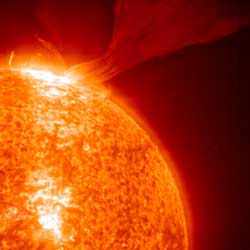
A huge solar explosion in 2001. Image credit: SOHO. Click to enlarge.
There’s a myth about the sun. Teachers teach it. Astronomers repeat it. NASA mission planners are mindful of it.
Every 11 years solar activity surges. Sunspots pepper the sun; they explode; massive clouds of gas known as “CMEs” hurtle through the solar system. Earth gets hit with X-rays and protons and knots of magnetism. This is called solar maximum.
There’s nothing mythical about “Solar Max.” During the most recent episode in 2000 and 2001, sky watchers saw auroras as far south as Mexico and Florida; astronomers marveled at the huge sunspots; satellite operators and power companies struggled with outages.
Now the sun is approaching the opposite extreme of its activity cycle, solar minimum, due in 2006. We can relax because, around solar minimum, the sun is quiet. Right?
“That’s the myth,” says solar physicist David Hathaway of the NASA Marshall Space Flight Center. The truth is, solar activity never stops, “not even during solar minimum.”
To show that this is so, Hathaway counted the number of X-class solar flares each month during the last three solar cycles, a period spanning 1970 to the present. X-flares are the most powerful kind of solar explosions; they’re associated with bright auroras and intense radiation storms. “There was at least one X-flare during each of the last three solar minima,” says Hathaway.
This means astronauts traveling through the solar system, far from the protection of Earth’s atmosphere and magnetic field, can’t drop their guard–ever.
Recent events bear this out: Rewind to January 10, 2005. It’s four years since solar maximum and the sun is almost blank–only two tiny sunspots are visible from Earth. The sun is quiet.
The next day, with stunning rapidity, everything changes. On January 11th, a new ‘spot appears. At first no more than a speck, it quickly blossoms into a giant almost as big as the planet Jupiter. “It happened so quickly,” recalls Hathaway. “People were asking me if they should be alarmed.”
Between January 15th and 20th, the sunspot unleashed two X-class solar flares, sparked auroras as far south as Arizona in the United States, and peppered the Moon with high-energy protons. Lunar astronauts caught outdoors, had there been any, would’ve likely gotten sick.
So much for the quiet sun.
It almost happened again last month. On April 25, 2005, small sunspot emerged and–d?j? vu–it grew many times wider than Earth in only 48 hours. This time, however, there were no eruptions.
Why not? No one knows.
Sunspots are devilishly unpredictable. They’re made of magnetic fields poking up through the surface of the sun. Electrical currents deep inside our star drag these fields around, causing them to twist and tangle until they become unstable and explode. Solar flares and CMEs are by-products of the blast. The process is hard to forecast because the underlying currents are hidden from view. Sometimes sunspots explode, sometimes they don’t. Weather forecasting on Earth was about this good … 50 years ago.
Researchers like Hathaway study sunspots and their magnetic fields, hoping to improve the woeful situation. “We’re making progress,” he says.
Good thing. Predicting solar activity is more important than ever. Not only do we depend increasingly on sun-sensitive technologies like cell phones and GPS, but also NASA plans to send people back to the Moon and then on to Mars. Astronauts will be “out there” during solar maximum, solar minimum and all times in between.
Will the sun be quiet when it’s supposed to be? Don’t count on it.
Original Source: Science@NASA Article
